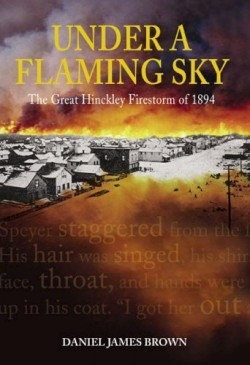Under a Flaming Sky
The Great Hinckley Firestorm of 1894
This book could have been called Trapped on a Scorching Train. It’s a churning, burning cauldron of horror—the true story of a Minnesota lumber town destroyed by wildfire in the late summer of 1894. The lasting image is of a packed passenger train, desperately slashing through searing sheets of flame, the engineer’s hands welded to the wheel. Rough and raw, Hinckley was a new town populated mostly by European immigrants. The summer had been hot and dry, with thirty days hotter than ninety degrees, and by September the piles of slash and logs, the sprawling lumberyard, and the town’s wooden buildings were sucked dry of moisture. A few miles to the south, two separate wild fires were on the move.
The author, who has previously co-written two books on writing, effectively uses traditional disaster-story structure here, introducing multiple characters, including his own great-grandfather, who died in the fire, and his great-grandmother and grandfather (then a nine-year-old boy), who survived. As the fires burn and the trains churn, Brown’s narrative races along, jumping from family to family, person to person.
Informatively, he discusses the escalating stages of wildfires. A “ground fire” smolders and creeps, then flames up to become a “surface fire.” Next comes the “crown fire,” leaping and surging from tree to tree. Finally, when two or more smaller fires merge into an eruption of flame hundreds of feet high, the “mass fire” is born. It was a mass fire, a “roiling, black and red monster,” that struck Hinckley, consuming more than 300,000 acres and claiming more than four hundred lives. Brown describes the fire as rearing on its haunches and clawing its way up, but he’s careful not to overdo the animalism.
Ultimately, it’s the trains that provide the narrative with its ferocious tension. As the fire sweeps toward town, three trains, two passenger and one freight, approach Hinckley from the other direction. Two of the trains hook up—one pushing, the other pulling. Packed with frightened passengers, they creep toward a precarious, burning trestle across the Grindstone River. With the two fires, the multiple trains, and the countless people and structures, Brown’s descriptive and detailed map of the town makes for a useful reference.
This is an emotional story of heroism and human foibles; of train engineers who make difficult decisions—to leave the station, to cross the bridge; of panicky passengers inside the stifling, suffocatingly hot coaches, some who turn away from the windows to avoid eye contact with their desperate neighbors running alongside the tracks; of families separated, families reunited, families lost.
Reviewed by
Rob Mitchell
Disclosure: This article is not an endorsement, but a review. The publisher of this book provided free copies of the book to have their book reviewed by a professional reviewer. No fee was paid by the publisher for this review. Foreword Reviews only recommends books that we love. Foreword Magazine, Inc. is disclosing this in accordance with the Federal Trade Commission’s 16 CFR, Part 255.

